|
Hedgehog, sugar glider, sto, short-tailed opossum, duprasi, squirrel, mouse, mice, rats, rabbit,
bunny, chinchilla, hamster, gerbil, rat, birds, guinea pig, degu, jird, dormouse, lemming, jerboa, prairie dog, chipmunk,
ferret, skunk, agouti, belgian hare, english lop
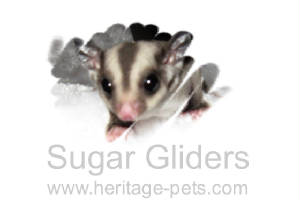
Sugar Gliders
Classification : Kingdom:
Animalia Phylum: Chordata Class: Mammalia Infraclass: Marsupialia
Order: Diprotodontia Family: Petauridae
Genus: Petaurus Species: P. breviceps
Binomial Name: Petaurus breviceps
Common English Names: Suggies, Sugar Glider,
Lesser Gliding Possum, Arboreal Gliding Possum, and Sugar squirrel
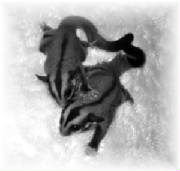
Five subspecies are currently known to exist; P. b. breviceps,
P. b. brevicep, P. b. longicaudatus, P. b. ariel, P. b. papuanus. In the wild, based solely on distribution, hybrids are unlikely
to exist.
Being that Gliders are relatively new exotic pets, in the beginning of the domestication process, there
was a fair bit of confusion when trying to identify the different species. Therefore, there is little doubt that hybrids now
exist.
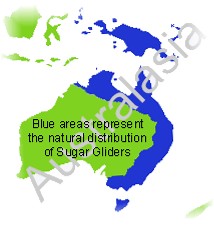
Conservation
Status in the wild: In their wild habitat this species is viewed as common and it’s populations
are considered stable and of least concern.Status in captivity: The highly social little Sugar Gliders are relatively new
to the pet trade. They have only been around in captive breeding programs in North America since the 1990’s and are
becoming increasingly popular as pets. Lately, quite a few breeders are taking great interest in them and are working with
the more highly priced mutations. In North America the demand for them as pets is high, and although they are becoming more
common, they are still considered a moderately priced pet to own. People should never own just one Sugar Glider. They thrive
on and need the companionship of other Gliders.
Origin
Natural distribution: They are native to the north and eastern parts of Australia, New Guinea, and
many of the surrounding islands. Typically they occupy forests and wooded areas where they live in the trees and hollows.
They form small tight-knit groups and establish territories. Sugar Gliders are primarily nocturnal but in a few areas they
can be seen during mid-day out and about in the scrub searching for food. They typically choose to shelter in hollows in gum
and eucalyptus trees where they build their nests out of leaves, twigs and grasses. In the wild, Sugar Gliders are mostly
nocturnal but in some isolated pockets they are developing diurnal and crepuscular habits.
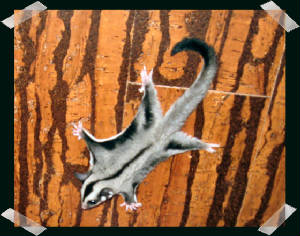
Appearance
In many ways Sugar Gliders resemble Flying Squirrels but are a vastly different species. Like Flying
Squirrels they have a large gliding membrane called the patagium, and are able to glide up to 50 meters or more and it has
been noted to be seen gliding to catch insects in flight. The Sugar Glider has plush thick, soft fur. The wild type is usually
blue-gray with a black stripe running from its nose to midway down his back, and the underside are off-cream in colour. In
captivity Sugar Gliders are available in numerous colours and colour patterns.
The average adult weight is between 80 -160grams with the females being a bit smaller than males. They
are around 5 – 6 inches long from nose to tail or 11-12 inches long with tail.
In total they have five toes, their hind feet have a large, opposable big toe that helps them grip
branches. Also on the hind feet, the second and third toes, which are partially fused together, form a grooming comb. With
the exception of the opposable toe all of the other toes are equipped with short, sharp claws.
The Sugar Glider has somewhat of a prehensile tail, which is covered with long, bushy fur. They use
their tails occasionally to carry twigs and leaves back to the nest. The tail is also used as a blanket and as a rudder that
they use when gliding. The tail also helps the glider balance better when it is high up on thin branches in the under-story
of the forest canopy.
The ears are relatively large, thin and hairless. They move independently of one another and are usually
in motion listening for minute sounds made by insects and other disturbances in their environment.
Being that they are primarily nocturnal their large dark coloured eyes are slightly off centered which
permits the animal to see better, especially at night.
Sexual Dimorphism: Males, testes are descended and the scrotum is visible. Females have a pouch on the mid-section on the belly, which is visible. A small,
bald diamond shaped scent gland, located on top of their head, easily identifies mature males.
Life Expectancy:
It is estimated that a glider could live 9- 10 years in the wild but they are likely to be preyed upon on before they have
a chance to reach that age. When housed properly and fed nutritious diets, captive-raised Sugar Gliders can live 12 or even
14 years, but their average life expectancy is generally closer to 9- 10 years.
Nutritional Requirements / Diet
Gliders are mainly insectivorous. They feed primarily on insects, larvae, spiders, and small vertebrates for the most of
the year. During the wet season flower blossoms, sap from eucalyptus trees, acacia gum, and nectar become a large part of
their regular diet.
To view our feeding schedule for Sugar Gliders please go to the Sugar Glider Nutrition page.
Temperature Requirements
Sugar Gliders are from temperate areas. Although withstand
moderate temperature fluctuations; they should be kept at temperatures at 21 degrees Celsius or higher. Babies are not able
to regulate their own body temperature and a couple degrees warmer will definitely add to their comfort. Like many small animals,
whenever conditions are not met, Sugar Gliders can put themselves in a state of torpor.
| The cage and set-ups that we use and recommend. |

|
Housing
Sugar Gliders should always be housed in small groups or pairs, in the largest cage that you can comfortably
fit in your home. (NEVER AN AQUARIUM). They are climbers and will utilize every inch of the cage. They are designed to move
and they are very social.
If you plan to breed Sugar Gliders the cage bars should be equal to what you will find on a typical
hamster or budgie cage. A normal size adult is usually large enough that he/she will not fit through cage wire spacing if
the cage you choose is similar to those that are designed for cockatiels but young pre-weaned babies have no problem squeezing
through the bars.
Gliders enjoy running on wheels and need a fair amount of climbing branches, a hide hut or two is a
must. They enjoy investigating new items so lots of safe toys that are changed and moved around regularly are very much appreciated.
Environmental stimulation is very important to the health and well being of any animal. Be sure to make small changes such
adding new toys and other interesting things for your Gliders to investigate. Make sure that what ever you give to your pet
is safe!
If you choose to use bedding, hay, and aspen shavings or specially designed pet bedding made out of
re-cycled newspaper are all safe choices. While not always practical for many pet owners, some people use cage liners.
We keep our Gliders in cages that are 48" wide x 48" tall and 24" deep. Their cages are equipped with
platforms, water bottles, several small food dishes, ropes, branches, exercise wheels, a couple of huts and lots of toys.
We don’t use a liner or a substrate for bedding. I instead we prefer to rinse their cage bottoms daily. On the bottom
we put in loosely bunched newspaper that we also change daily.
Behaviour in Captivity
I can not stress enough how important it is for Sugar Gliders to be housed in pairs or small groups.
They are highly social and depend on each other to thrive. Some breeders, hoping for a quick sale, will tell you they will
adopt you as their companion. BUT THINK ABOUT IT. Are you there with your pet 24 hours a day, Do you groom him or her throughout
the day and night. Do you eat with it? They really are meant to live in-groups and although they may live as a single pet
for while, they will not thrive nor will they be happy. If you want a single pet then you really should be considering other
types of animals. There are a lot of species that do not like their own species, outside of the breeding season; these are
the types of animals you should be considering.
Grooming: Sugar Gliders are very
clean animals. They were even born equipped with their own grooming tool. Besides constantly cleaning themselves, they also
groom other members of their group; this helps secure social bonds. Scent marking, no matter what we think of it, is an important
part of Sugar Glider grooming. Sugar Gliders find it intoxicating while some humans find it offensive.

Keeping Gliders with other Pets: Not every species has a natural way to defend itself. When it comes to
Sugar Gliders their best defense is flee and to take flight. If you talk to some people, you will hear how well Gliders get
on with other pets. If you search the Internet you will surely come by some cute pictures or videos with Sugar Gliders playing
with personal pets. Obviously, if pictures are being taken there was someone in the room supervising the pets while they are
interacting with one another.
Never assume that your Glider will be safe around other pets. In the wild, Sugar Gliders have been
known to catch and eat small birds and rodents. Gliders are also considered prey animals. Feral cats, birds of prey, canines
and other predators think of them as ‘snack food’. While fluffy might be trained not to bother your Pet Glider,
can you be 100% sure that something won’t go wrong if the two animals were left together, unattended? My 2 dogs and
cat are seniors. They barely get off the couch. Yet, I know that I would not ever leave my Gliders unsupervised with them
or with any of my other animals.
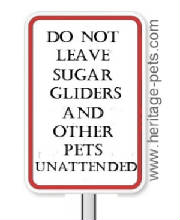
Breeding
Breeding age females are polyestrous and go into heat several times a year. Estrus is typically a 29-day cycle and they
can reproduce at 8-12 months old. They are capable of reproducing until they are over 10 years old. Being a marsupial they
are capable of embryonic diapause.
Males can breed throughout the year and are typically ready to breed between 12-14 months of age. In captivity they can
start breeding as young as four to six months, but at such a young a age they may not be mature enough to care for their offspring.
Sugar gliders are polygamous. When kept in a colony, usually one or two older dominant males father the young. They do
most of the territorial maintenance and scent marking. Both sexes take turns caring for their babies, which are called Joeys.
Copulation usually occurs in the evening and is often accompanied by grumping chirps that I can only describe as complaining.
Females have 2 uteruses and the males can inseminate one or both of the female’s uteri, because he has a bifurcated
(two-pronged) penis.
Breeding season normally begins around June through late October but captive raised gliders can breed all year. Females
can produce 3-4 litters with 1-2 (rarely 3) Joeys a year. Ideally in the wild, they may only have 1 or 2 litters a year and
can breed until the are close to ten years of age. If you do plan on breeding, we suggest that you only permit your glider
to produce 1 or 2 litters a year as not to burn her out.
Unless embryonic diapause occurs, after 16 days gestation (after mating) the fetuses are born and instinctively climb to
the mother’s pouch where they remain, nursing for 60 to 70 days.
Joeys are dependent on the parents and other group members for quite a while. Typically they are weaned at 8 weeks (after
it leaves the pouch) but should not be considered fully independent for another 4-6 weeks after they have been weaned.
| Only a week or so out of pouch |
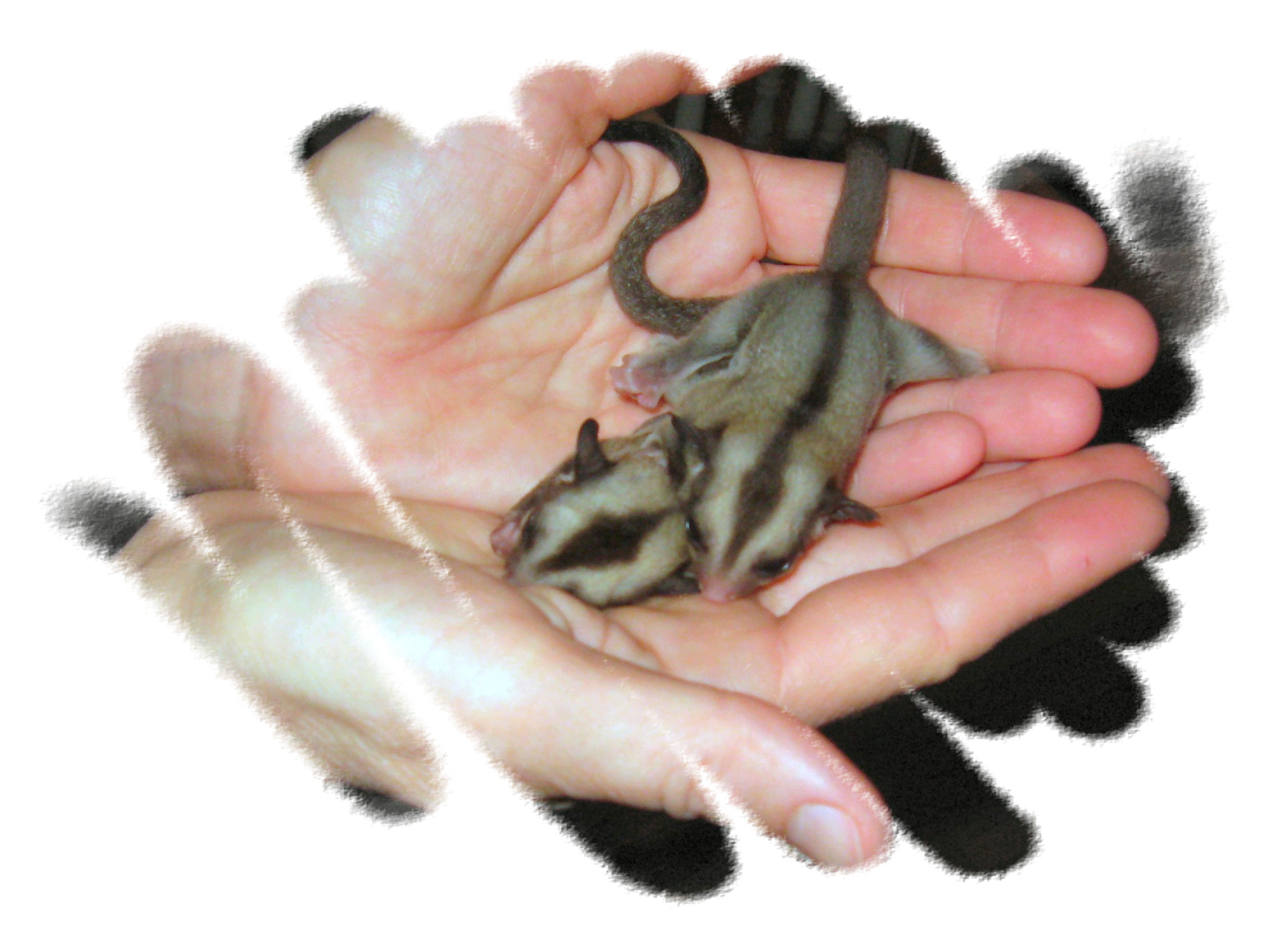
|
Colour Mutations
In captivity there are many colour varieties available. The list of new colour mutations is growing every few months. Leucistic,
Mosaic, Blonde, Platinum, are just a few of the most common colours being worked with, some of which we own ourselves. Some
of the colour mutations are totally established while others are still in the working/ study phase. Unfortunately like other
genetic mutations, colour genes can play havoc on the health and reproductive ability of an animal. Sometimes they even shorten
life expectancy and can cause other health problems such as skin disorders, blindness, etc. If colour is the deciding factor
for you, my suggestion when deciding on what animal to purchase, to give lots of consideration and have a few discussions
with a few different breeders and other people that are familiar with genetics.
Ailments and Veterinary Requirements
Sugar Gliders can become calcium deficient and should be supplemented with foods rich in calcium. We provide ours with
extra calcium and vitamins every other day. All animals can benefit from annual visits to a qualified Veterinarian. Be sure
that your vet is knowledgeable about Sugar Gliders.
Costs to consider
The costs to set up a suitable habitat can vary but you can expect to pay in the neighborhood of $300.00 or more for a
reasonably decent setup (including the cage, a few toys, wheels, sleeping dens etc.). A pair of Sugar Gliders will likely
cost around $350.00 and up, depending on colour, sexes, etc.
Where to purchase
Ideally all pets should be purchased from a "Specialist Breeders". If you are planning to breed Gliders, buying your breeding
stock from an experienced breeder will likely be worth the investment. They are usually proud of their own animals and can
be a great source of information. Not all Pet Stores are bad, nor are all of the people who work in them, mean people. Actually
some very knowledgeable people work in them. Unfortunately, they are paid to sell and they are a real business. That being
said you’ll need to decide for yourself whether or not you feel comfortable buying pets from them.
Wherever you choose to purchase your pet from as long as you have done all of your research first and you are comfortable
with the people that you are dealing with and feel that a Glider is right for you; then you will you be in a better position
to make an educated decision and know what you are committing yourself to.
Having to ‘re-home’ your pet
For some people having to make the decision to give up a pet may be one of the hardest things they will ever have to do.
It can be very emotional and stressful for the caregiver and the pet. If you find yourself in an emergency situation and need
to re-home your pet, try contacting the breeder to see if they can help. We believe that most ethical breeders will do their
best to help. Often, in the case of a real emergency, most conscientious breeders will offer to take back the animal. This
is a good habit that responsible breeders get into, not only does it prevent animals from ending up in shelters or sanctuaries
it also makes people think twice before abandoning them in the wild.
People contact us regularly to see if we can help them sell their pet. PLEASE NOTE …We will not help you sell
your pet! However if you ever find yourself in a position whereby you can no longer adequately care for your Sugar Glider
or you feel that your pet Glider needs to be in a home with someone more experienced, you are free to call us. We do realize
that every situation is different but we will do our best to suggest a few options for you to consider before you decide to
re-home your pet. Occasionally, if we have the space and time, we will take in Gliders that are in need new homes. Just be
aware that if we do commit to taking in your pet, we will keep them for as long as it takes to find them a suitable home.
We will not keep them because we need to know the lineage and history on all of our animals in our breeding program. We do
have a special needs page on our site for people looking to adopt/purchase animals in need of rehoming. If we can not personally
accommodate another animal in our own home then we may be able to recommend someone who can.
Clubs, Associations and Breeder links
If you are an experienced specialist breeder or a legitimate specialty club and would like to add a reciprocal link to
our site please feel free to email us. Please note that we will not provide links to Rescue Organizations that are not open
to public, unless we have the opportunity and time to personally inspect the "Rescue" organizations, first. Sorry to all of
the people, who truly dedicate their time to legitimate animal rescue, unfortunately too often people misrepresent themselves
pretending to be licit or scrupulous rescuers.
Cute pictures of some of our Gliders
|

